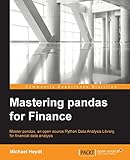Mastering pandas for finance : master pandas, an open source Python data analysis library, for financial data analysis / Michael Heydt
Material type: TextPublication details: Mumbai : Packt Publishing, 2015.Description: ix, 275 pages : 28 cmISBN:
TextPublication details: Mumbai : Packt Publishing, 2015.Description: ix, 275 pages : 28 cmISBN: - 9781783985104
- 005.133 HEY
| Item type | Current library | Call number | Status | Date due | Barcode | |
|---|---|---|---|---|---|---|
| Books | Institute of Public Enterprise, Library S Campus | 005.133 HEY (Browse shelf(Opens below)) | Available | 47717 | ||
| Books | Institute of Public Enterprise, Library S Campus | 005.133 HEY (Browse shelf(Opens below)) | Available | 47718 |
Mastering pandas for Finance
Table of Contents
Mastering pandas for Finance
Credits
About the Author
About the Reviewers
www.PacktPub.com
Support files, eBooks, discount offers, and more
Why subscribe?
Free access for Packt account holders
Preface
What this book covers
What you need for this book
Who this book is for
Conventions
Reader feedback
Customer support
Downloading the example code
Errata
Piracy
Questions
1. Getting Started with pandas Using Wakari.io
What is Wakari?
Creating a Wakari cloud account
Updating existing packages
Installing new packages
Installing the samples in Wakari
Summary
2. Introducing the Series and DataFrame
Notebook setup
The main pandas data structures – Series and DataFrame
The Series
The DataFrame
The basics of the Series and DataFrame objects
Creating a Series and accessing elements
Size, shape, uniqueness, and counts of values
Alignment via index labels
Creating a DataFrame
Example data
Selecting columns of a DataFrame
Selecting rows of a DataFrame using the index
Slicing using the [] operator
Selecting rows by the index label and location – .loc[] and .iloc[]
Selecting rows by the index label and/or location – .ix[]
Scalar lookup by label or location using .at[] and .iat[]
Selecting rows using the Boolean selection
Arithmetic on a DataFrame
Reindexing the Series and DataFrame objects
Summary
3. Reshaping, Reorganizing, and Aggregating
Notebook setup
Loading historical stock data
Organizing the data for the examples
Reorganizing and reshaping data
Concatenating multiple DataFrame objects
Merging DataFrame objects
Pivoting
Stacking and unstacking
Melting
Grouping and aggregating
Splitting
Aggregating
Summary
4. Time-series
Notebook setup
Time-series data and the DatetimeIndex
Creating time-series with specific frequencies
Representing intervals of time using periods
Shifting and lagging time-series data
Frequency conversion of time-series data
Resampling of time-series
Summary
5. Time-series Stock Data
Notebook setup
Obtaining historical stock and index data
Fetching historical stock data from Yahoo!
Fetching index data from Yahoo!
Visualizing financial time-series data
Plotting closing prices
Plotting volume-series data
Combined price and volumes
Plotting candlesticks
Fundamental financial calculations
Calculating simple daily percentage change
Calculating simple daily cumulative returns
Analyzing the distribution of returns
Histograms
Q-Q plots
Box-and-whisker plots
Comparison of daily percentage change between stocks
Moving windows
Volatility calculation
Rolling correlation of returns
Least-squares regression of returns
Comparing stocks to the S&P 500
Summary
6. Trading Using Google Trends
Notebook setup
A brief on Quantifying Trading Behavior in Financial Markets Using Google Trends
Data collection
The data from the paper
Gathering our own DJIA data from Quandl
Google Trends data
Generating order signals
Computing returns
Cumulative returns and the result of the strategy
Summary
7. Algorithmic Trading
Notebook setup
The process of algorithmic trading
Momentum strategies
Mean-reversion strategies
Moving averages
Simple moving average
Exponentially weighted moving average
Technical analysis techniques
Crossovers
Pairs trading
Algo trading with Zipline
Algorithm – buy apple
Algorithm – dual moving average crossover
Algorithm – pairs trade
Summary
8. Working with Options
Introducing options
Notebook setup
Options data from Yahoo! Finance
Implied volatility
Volatility smirks
Calculating payoff on options
The call option payoff calculation
The put option payoff calculation
Profit and loss calculation
The call option profit and loss for a buyer
The call option profit and loss for the seller
Combined payoff charts
The put option profit and loss for a buyer
The put option profit and loss for the seller
The pricing of options
The pricing of options with Black-Scholes
Deriving the model
The value of the cash to buy
The value of the stock received
The formulas
d1 and d2
Black-Scholes using Mibian
Charting option price change over time
The Greeks
Calculation and visualization
Summary
9. Portfolios and Risk
Notebook setup
An overview of modern portfolio theory
Concept
Mathematical modeling of a portfolio
Risk and expected return
Diversification
The efficient frontier
Modeling a portfolio with pandas
Constructing an efficient portfolio
Gathering historical returns for a portfolio
Formulation of portfolio risks
The Sharpe ratio
Optimization and minimization
Constructing an optimal portfolio
Visualizing the efficient frontier
Value at Risk
Summary
Index
This book will teach you to use Python and the Python Data Analysis Library (pandas) to solve real-world financial problems.
Starting with a focus on pandas data structures, you will learn to load and manipulate time-series financial data and then calculate common financial measures, leading into more advanced derivations using fixed- and moving-windows. This leads into correlating time-series data to both index and social data to build simple trading algorithms. From there, you will learn about more complex trading algorithms and implement them using open source back-testing tools. Then, you will examine the calculation of the value of options and Value at Risk. This then leads into the modeling of portfolios and calculation of optimal portfolios based upon risk. All concepts will be demonstrated continuously through progressive examples using interactive Python and IPython Notebook.
By the end of the book, you will be familiar with applying pandas to many financial problems, giving you the knowledge needed to leverage pandas in the real world of finance.
What You Will Learn
Modeling and manipulating financial data using the pandas DataFrame
Indexing, grouping, and calculating statistical results on financial information
Time-series modeling, frequency conversion, and deriving results on fixed and moving windows
Calculating cumulative returns and performing correlations with index and social data
Algorithmic trading and backtesting using momentum and mean reversion strategies
Option pricing and calculation of Value at Risk
Modeling and optimization of financial portfolios
There are no comments on this title.


 2cqr automation private limited, Chennai. All Rights Reserved.
2cqr automation private limited, Chennai. All Rights Reserved.